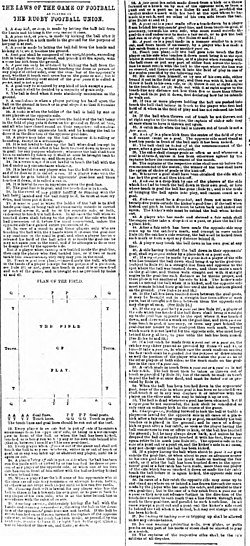
The laws of Rugby Union are defined by World Rugby (originally the International Rugby Football Board, and later International Rugby Board) and dictate how the game should be played. They are enforced by a referee, generally with the help of two assistant referees.
When playing a game of Rugby Union the overall objective is to score more points than the opposition through tries and goals. A try worth five points is scored when a team grounds the ball in the opposition's in-goal. A conversion (kick at a goal) is then attempted by either place- or drop-kicking the ball between the H-shaped goal posts and above the crossbar. If successful this is worth two extra points.
Penalties are awarded for major infringements such as offside or foul play and the team that is awarded them can choose to take a shot at goal in an attempt to score three points. They can also use the penalty to kick for territory or tap the ball and continue running it. Three points are awarded if a team member drop kicks a goal during general play.
The game of Rugby evolved at Rugby School from early folk football, with the rules of play being agreed upon before the start of each match. Some Rugby clubs were also early members of The Football Association, leaving after they left out rules for "running with the ball" and "hacking" when framing their code in 1863. The rugby laws were standardised in 1870 and the International Rugby Football Board (now World Rugby) was formed in 1886. In 1930 the IRFB was made responsible for developing any new laws. These laws have changed over time. The point value for scoring tries has increased from zero to five, penalties were initially worth just two points and drop goals four. The ball has changed too, going from a pig's bladder to a rubber bladder in first a leather and nowadays, a plastic case, and becoming more oval in shape. Player numbers were initially 20 each side, but reduced to 15 in 1877. The laws are always being tweaked in the early twenty-first century, with some of the biggest changes being introduced in 2009.
The game is usually played on a grass field approximately 70 metres (230 ft) by 100 metres (330 ft). At each end of the field are the goal posts and an in-goal area. Games last for eighty minutes and are divided into two forty-minute halves. Each team defends one end and attempts to score points through tries and goals. One team kicks the ball towards the opposition starting play. At half time they swap ends, with the other team kicking off. After a successful kick-off the ball is in general play and can be passed, kicked, caught, picked up or grounded by any player. The ball can be kicked in any direction, but may only be passed backwards. Players attempt to stop the opposition running the ball by tackling them. Rucks form when at least one player from each team is on their feet and the ball is on the ground. Mauls are formed when the ball carrier is held by at least one of the opposition and a teammate is also bound to them. Players can compete for the ball at tackles, rucks and mauls in accordance with the laws.
Scrums are used to start play after minor infringements (knock-ons and forward passes) and when the ball becomes unplayable. All eight members of the forwards must be involved in the scrum provided the team still has all fifteen players present. Players involved in the scrum stay bound to each other and the opposition until it is finished and the rest, except the scrum-half, must be positioned at least five metres back. The two teams push against each other and the hookers strike for the ball once the scrum half puts the ball into the "tunnel" (gap between the two front rows). The scrum half must put the ball straight down the centre of the tunnel, if the scrum half deliberately puts the ball in at an angle to his second rows feet, (feeding the ball), the opposition are awarded the 'put in'.
Lineouts are used to restart play when the ball has crossed the sidelines. Players form two parallel lines perpendicular to the sideline and the team that did not put the ball out throws it straight down the middle. Players in the line-out can be lifted by teammates as they attempt to win the ball.